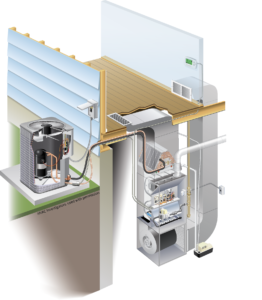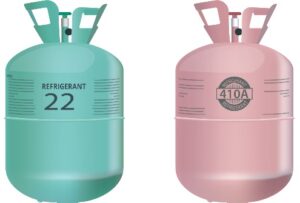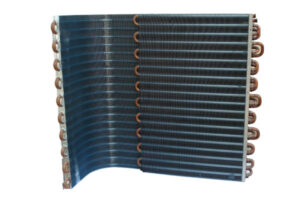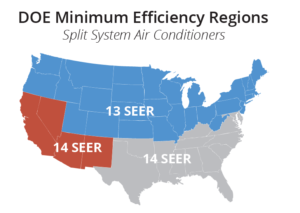6 Basic HVAC System Terms Every Adjuster Should Know
Settling a claim with HVAC equipment shouldn’t feel like you need to read a manufacturer’s manual or have another lesson in thermodynamics. Understanding 6 key terms related to these complex systems can help adjusters settle claims related to them more confidently and accurately.
1. HVAC
Technical jargon for any industry can turn into alphabet soup. Though most frequently referred to as HVAC, it stands for Heating, Ventilation, and Air Conditioning. This describes what the equipment does to deliver preferred temperatures and air quality to a space.
It’s often not clear that air conditioning is the process of cooling air through the transfer of heat and humidity from warmer air to something colder. To make air feel cooler and more comfortable, water is removed from the air.
2. Split System (vs. Package Unit)

Traditional HVAC equipment has multiple important system types – most notably, the condensing unit and air handler or furnace. Condensing units remove heat from air, while furnaces and air handlers have heat sources to warm the air. This critical equipment is connected by copper linesets. After the air reaches its preferred temperature, it’s circulated through ductwork.
In a split system, which is the most common type of residential HVAC system, the condensing unit is outside while the air handler or furnace is inside. Package units, more frequently used in commercial applications, have the main components housed in one box kept outside.
3. Refrigerant – R-410A or R-22

Refrigerant, which absorbs heat when the system is in cooling mode, is constantly moving and changing from gas to a liquid and back through closed loops.
R-22 was the most widely used refrigerant until the Montreal Protocol on Substances that Deplete the Ozone Layer international agreement impacted the use of R-22 and other ozone-depleting substances. As of Jan. 1, 2020, virgin R-22 can no longer be manufactured or imported into the United States, though reclaimed R-22 can be used to maintain and repair existing HVAC systems.
The main refrigerant used by manufacturers is R-410A. This refrigerant also has some effects linked with global warming, but an alternative has not yet been chosen.
R-22 and R-410A are not interchangeable. If the condensing unit used R-22, the policyholder would need to change the condensing unit and evaporator coil and flush the lineset to make it compatible with a furnace. A full replacement would be required if the split system had a heat pump.
4. Condenser Coils

Condenser coils are wrapped around the outside of a condensing unit in a split system and one or two package unit sides. After absorbing heat from the indoor unit, refrigerant being pumped by the compressor travels through the condenser coil tubes as a hot, high-pressure vapor. Heat is transferred to the surrounding air through the coils, and the refrigerant becomes a warm, high-pressure liquid to restart the heat absorption cycle.
In traditional coils, copper or aluminum tubes carry refrigerant and are surrounded by thin aluminum fins that can easily be bent, dented, or flattened. Package units may use microchannel coils, which have rigid aluminum ribbons in between horizontal channels that carry the refrigerant and are more difficult to damage.
5. Seasonal Energy Efficiency Ratio (SEER)

In 2015, the U.S. Department of Energy analyzed HVAC system efficiency and set minimum standards based on climates throughout the country. The Seasonal Energy Efficiency Ratio (SEER) is the total cooling output during the cooling season over the total electric energy input during the cooling season. More efficient systems have a higher SEER rating.
Policyholders may have to replace the condensing unit and evaporator coil if the outdoor equipment isn’t compatible with indoor components, particularly if parts of an outdated system no longer meet minimum federal requirements. Other components can be added to make the systems compatible and ensure system efficiency.
6. Heat Pump vs. Furnace
Furnaces are forced-air systems that are a residential property’s primary heating source. Air is warmed by a heat source, including burning natural gas, propane, or oil, and then that warm air is sent through the ductwork and supply registers.
Heat pumps are condensing units that can operate in heating and cooling modes through a reversing valve. Unlike a furnace, heat pumps don’t generate heat but transfer it like in the cooling process. Heat is absorbed from the ambient air and returned to warm up the air in a space. Heat pumps are used in conjunction with air handlers, which have electric heat strips to supplement additional heat when necessary.
Need More Help with Components?
For another look at HVAC system components, insurance professionals can receive copies of our Package Unit Glossary, Split System Glossary, Heat Pump Glossary, and Boiler Glossary, which have labeled schematics with short descriptions to help adjusters.
The HVACi team is full of experts who are ready to help carriers settle claims with HVAC and Refrigeration equipment. Use just the facts to determine cause of loss, scope of damage, and best repairs and replacement processes to return your policyholders’ equipment to pre-loss condition. To obtain your comprehensive, data-driven assessment report, submit a claim.

